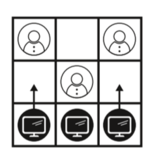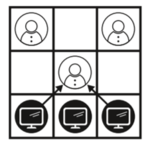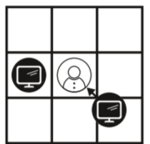Man, Machine!: Unterschied zwischen den Versionen
(Die Seite wurde neu angelegt: „"MENSCH, Maschine" ist ein Brettspiel, welches die grundlegenden Prinzipien vom Maschinellen Lernen am Beispiel von Bauernschach vermittelt. Es ist 2019 im Rah…“) |
(Übersetzung eingefügt) |
||
| Zeile 1: | Zeile 1: | ||
" | "Man, Machine" is a board game, which teaches the basic principles of machine learning using the example of peasant chess. It was created in 2019 as part of the "Wissenschaftsjahr 2019" on the topic of "artificial intelligence" with additional teaching materials on this topic.<br /> | ||
==Instructions== | |||
== | ===What´s the game?=== | ||
The human plays a simple version of peasant chess against a simulated machine that makes its moves according to predetermined rules. Both have three pieces (pawns from the chess game) with which they each try to win after a maximum of 3 moves from each. To see changes in the game strategy of the machine, several rounds are played.<br /> | |||
<br /> | |||
=== | ===How is the game set up?=== | ||
Pawn chess can only be played by two opponents. However, in order to follow all the rules of the machine so that it can decide to make a move, the tasks of the machine are divided so that "HUMAN, machine" can be played by 5 people. The people sit in a circle around the playing field. | |||
Each player takes on a special role, which is explained to him by a role card. | |||
{| class="wikitable" | {| class="wikitable" | ||
|+ | |+Roles in the game "Man, Machine!" | ||
! | !Role 1 | ||
! | !Role 2 | ||
! | !Role 3 | ||
! | !Role 4 | ||
! | !Role 5 | ||
|- | |- | ||
| | |Human | ||
| colspan="4" | | | colspan="4" |Machine | ||
|- | |- | ||
| | | | ||
| | |Situation evaluator (Machine) | ||
| | |Move provider | ||
| | |Move selector | ||
| | |Situation evaluator (Human) | ||
|- | |- | ||
| | | | ||
| Zeile 37: | Zeile 34: | ||
|} | |} | ||
==== | ====Game materials==== | ||
The game consists of: | |||
* A game board, | |||
* 6 game pieces (3 for the human and 3 for the machine), | |||
* 24 wipeable situation cards, | |||
* 12 colour cards, | |||
<br /> | * Five role cards, | ||
* A situation overview with the front pages of the 24 situation cards, | |||
* A wipeable move overview with the backs of the 24 situation cards, | |||
* A water-soluble pen, | |||
* 5 score cards, | |||
* A game sequence diagram and | |||
* This quick guide with the explanation of the rules of the game.<br /> | |||
==== | ====Rules for peasant chess==== | ||
In "Man, Machine!" you play the game of peasant chess between a human and a machine on a small playing field with 3 by 3 squares. The aim of the game is to defeat the opponent by either throwing all his pieces out of the game, blocking him or by using your own pieces to reach the opponent's side of the board. | |||
Each player has three game pieces, which are placed on opposite sides of the board. Human and machine take turns drawing.<ref name=":1">Übersetzung nach: Bundesministerium für Bildung und Forschung, 2019 - Spielanleitung Schüler<br /></ref> | |||
The playing pieces can be moved like pawns in chess. So there are two move options:<ref name=":0" /> | |||
{| class="wikitable" | {| class="wikitable" | ||
|+ | |+ | ||
| Zeile 72: | Zeile 61: | ||
!2. | !2. | ||
|- | |- | ||
| | |One square straight ahead, if the square is not already occupied by another piece. | ||
| | |A square diagonally to capture an opponent's piece located there. | ||
|- | |- | ||
|[[Datei:Gegner Blockieren.png|zentriert|mini|157x157px| | |[[Datei:Gegner Blockieren.png|zentriert|mini|157x157px|Image from "Lehrerbegleitpräsenta-tion", BMBF]] | ||
|[[Datei:Gegner schlagen.png|zentriert|mini|150x150px| | |[[Datei:Gegner schlagen.png|zentriert|mini|150x150px|Image from "Lehrerbegleitpräsenta-tion", BMBF]] | ||
|- | |- | ||
| | | | ||
| Zeile 84: | Zeile 73: | ||
There are three ways to win:<ref name=":0">Übersetzung nach: Bundesministerium für Bildung und Forschung, 2019, wissenschaftsjahr.de/2019/jugendaktion/<br /></ref> | |||
<br /> | <br /> | ||
| Zeile 92: | Zeile 81: | ||
!1.!!2.!!3. | !1.!!2.!!3. | ||
|- | |- | ||
| | |A player reaches the opponent's side of the board with his piece.||All of the opponent's pieces are blocked, so the opponent cannot make any more moves.||All opposing pieces were thrown out of the game. | ||
|- | |- | ||
|[[Datei:Gewinnvariante1.png|mini|150x150px|alternativtext=| | |[[Datei:Gewinnvariante1.png|mini|150x150px|alternativtext=|Image from "Lehrerbegleitpräsenta-tion", BMBF]] | ||
||[[Datei:Gewinnvariante 2.png|mini|150x150px|alternativtext=| | ||[[Datei:Gewinnvariante 2.png|mini|150x150px|alternativtext=|Image from "Lehrerbegleitpräsenta-tion", BMBF]]||[[Datei:Gewinnvariante 3.png|mini|150x150px|alternativtext=|Image from "Lehrerbegleitpräsenta-tion", BMBF]] | ||
|} | |} | ||
=== | ===Before the game=== | ||
Place the game board unfolded in front of you and get the game material ready. To do this, you place the human game pieces on the human side of the board and the machine game pieces on the machine side of the board. The 24 situation cards are stacked on the three boxes labelled "Moves" according to their designations A, B or C and their consecutive numbering. Then the colour cards are sorted according to their colour and placed on the corresponding colour boxes on the board. | |||
Finally, you hand out the role cards. One person takes over the role of the human and plays as cleverly as possible against the machine. The remaining players together take over the task of the machine.<ref name=":1" /> | |||
<br /> | <br /> | ||
=== | ===How "Man, machine!" works=== | ||
The human starts the game and draws first in each new round. The human moves either with his right or middle figure. Moving with the left figure is equivalent to moving the right figure. This move is then merely mirrored. | |||
Then it's the machine's turn: | |||
# | # First the situation evaluator (machine) has the task to classify the current game situation. He's checking to see if the machine has lost. If not, he looks for the current game situation on the situation overview and announces it (e.g. A2). | ||
# | # The move provider takes the announced situation card from the corresponding stack and looks on the back to see which colours (blue, yellow, green or red) it can be played with. For each of the possible colours one colour card is taken from the colour card stacks. They are mixed and then offered to the move selector for drawing in a concealed manner. | ||
# | # The move selector randomly draws a colour card and places it, together with the situation card (back to top), on the corresponding marked square of the current turn on the board. Then the move selector moves the machine’s piece like it’s indicated by the colour (arrow in the same colour). | ||
# | # After the machine has drawn, the situation evaluator (human) checks whether the machine has already won. If this is not the case, the next round begins and the person draws again. | ||
This procedure is repeated until either the man or the machine has won (maximum 3 moves of the machine). The result of the match is entered on the result sheet by the respective situation evaluators. If the machine has lost, the move provider crosses out the colour of the last move on the situation card and on the move overview. If all the colours on a situation card are crossed out, it is removed from the game.<ref name=":1" /> | |||
[[Datei: | [[Datei:Ablauf englisch.png|alternativtext=|mini|500x500px|Game sequence diagram]] | ||
<references /> | <references /> | ||
[[Kategorie:Gymnasium]] | [[Kategorie:Gymnasium]] | ||
Version vom 16. März 2020, 16:16 Uhr
"Man, Machine" is a board game, which teaches the basic principles of machine learning using the example of peasant chess. It was created in 2019 as part of the "Wissenschaftsjahr 2019" on the topic of "artificial intelligence" with additional teaching materials on this topic.
Instructions
What´s the game?
The human plays a simple version of peasant chess against a simulated machine that makes its moves according to predetermined rules. Both have three pieces (pawns from the chess game) with which they each try to win after a maximum of 3 moves from each. To see changes in the game strategy of the machine, several rounds are played.
How is the game set up?
Pawn chess can only be played by two opponents. However, in order to follow all the rules of the machine so that it can decide to make a move, the tasks of the machine are divided so that "HUMAN, machine" can be played by 5 people. The people sit in a circle around the playing field.
Each player takes on a special role, which is explained to him by a role card.
| Role 1 | Role 2 | Role 3 | Role 4 | Role 5 |
|---|---|---|---|---|
| Human | Machine | |||
| Situation evaluator (Machine) | Move provider | Move selector | Situation evaluator (Human) | |
Game materials
The game consists of:
- A game board,
- 6 game pieces (3 for the human and 3 for the machine),
- 24 wipeable situation cards,
- 12 colour cards,
- Five role cards,
- A situation overview with the front pages of the 24 situation cards,
- A wipeable move overview with the backs of the 24 situation cards,
- A water-soluble pen,
- 5 score cards,
- A game sequence diagram and
- This quick guide with the explanation of the rules of the game.
Rules for peasant chess
In "Man, Machine!" you play the game of peasant chess between a human and a machine on a small playing field with 3 by 3 squares. The aim of the game is to defeat the opponent by either throwing all his pieces out of the game, blocking him or by using your own pieces to reach the opponent's side of the board.
Each player has three game pieces, which are placed on opposite sides of the board. Human and machine take turns drawing.<ref name=":1">Übersetzung nach: Bundesministerium für Bildung und Forschung, 2019 - Spielanleitung Schüler
</ref>
The playing pieces can be moved like pawns in chess. So there are two move options:<ref name=":0" />
There are three ways to win:<ref name=":0">Übersetzung nach: Bundesministerium für Bildung und Forschung, 2019, wissenschaftsjahr.de/2019/jugendaktion/
</ref>
Before the game
Place the game board unfolded in front of you and get the game material ready. To do this, you place the human game pieces on the human side of the board and the machine game pieces on the machine side of the board. The 24 situation cards are stacked on the three boxes labelled "Moves" according to their designations A, B or C and their consecutive numbering. Then the colour cards are sorted according to their colour and placed on the corresponding colour boxes on the board.
Finally, you hand out the role cards. One person takes over the role of the human and plays as cleverly as possible against the machine. The remaining players together take over the task of the machine.<ref name=":1" />
How "Man, machine!" works
The human starts the game and draws first in each new round. The human moves either with his right or middle figure. Moving with the left figure is equivalent to moving the right figure. This move is then merely mirrored.
Then it's the machine's turn:
- First the situation evaluator (machine) has the task to classify the current game situation. He's checking to see if the machine has lost. If not, he looks for the current game situation on the situation overview and announces it (e.g. A2).
- The move provider takes the announced situation card from the corresponding stack and looks on the back to see which colours (blue, yellow, green or red) it can be played with. For each of the possible colours one colour card is taken from the colour card stacks. They are mixed and then offered to the move selector for drawing in a concealed manner.
- The move selector randomly draws a colour card and places it, together with the situation card (back to top), on the corresponding marked square of the current turn on the board. Then the move selector moves the machine’s piece like it’s indicated by the colour (arrow in the same colour).
- After the machine has drawn, the situation evaluator (human) checks whether the machine has already won. If this is not the case, the next round begins and the person draws again.
This procedure is repeated until either the man or the machine has won (maximum 3 moves of the machine). The result of the match is entered on the result sheet by the respective situation evaluators. If the machine has lost, the move provider crosses out the colour of the last move on the situation card and on the move overview. If all the colours on a situation card are crossed out, it is removed from the game.<ref name=":1" />

<references />




